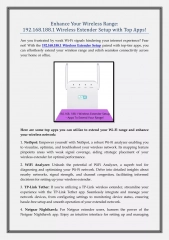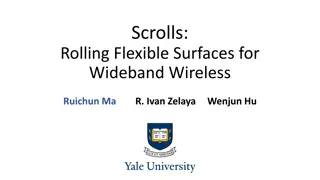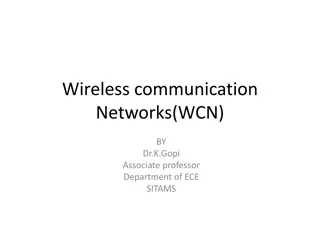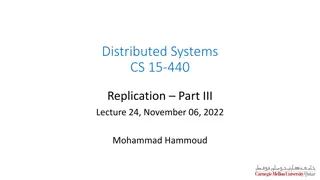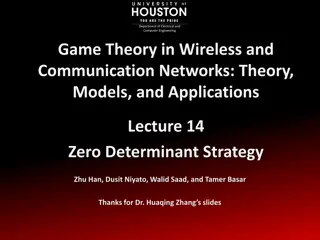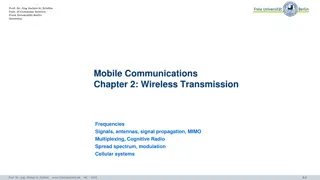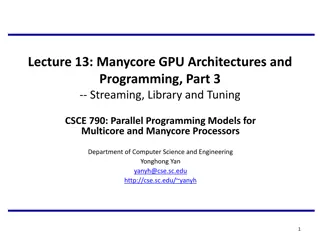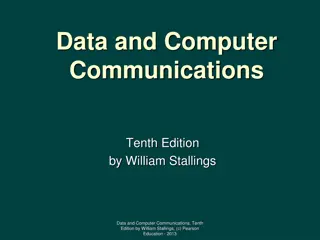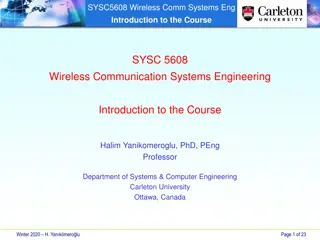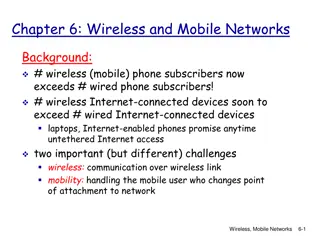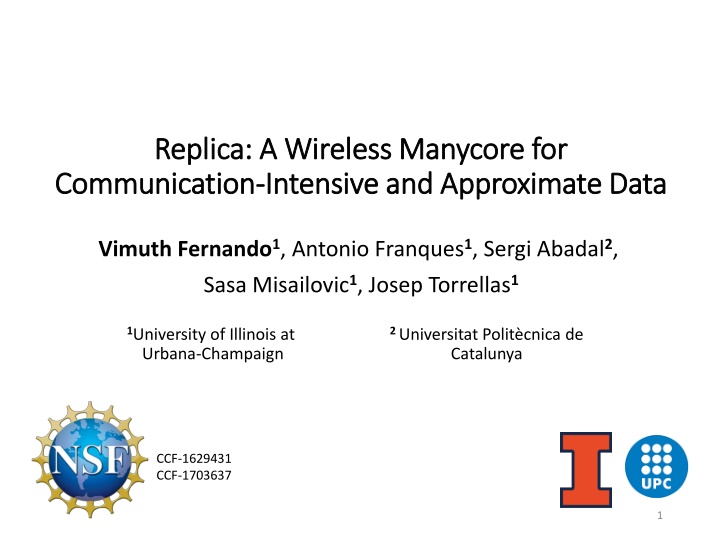
Replica: A Wireless Manycore for Communication
Cutting-edge research on a wireless manycore system designed for communication-intensive and approximate data processing. Featuring motivating concepts, network-on-chip architecture, and innovative on-chip wireless synchronization solutions like WiSync.
Download Presentation

Please find below an Image/Link to download the presentation.
The content on the website is provided AS IS for your information and personal use only. It may not be sold, licensed, or shared on other websites without obtaining consent from the author. If you encounter any issues during the download, it is possible that the publisher has removed the file from their server.
You are allowed to download the files provided on this website for personal or commercial use, subject to the condition that they are used lawfully. All files are the property of their respective owners.
The content on the website is provided AS IS for your information and personal use only. It may not be sold, licensed, or shared on other websites without obtaining consent from the author.
E N D
Presentation Transcript
Replica: A Wireless Manycore for Replica: A Wireless Manycore for Communication Communication- -Intensive and Approximate Data Intensive and Approximate Data Vimuth Fernando1, Antonio Franques1, Sergi Abadal2, Sasa Misailovic1, Josep Torrellas1 2 Universitat Polit cnica de Catalunya 1University of Illinois at Urbana-Champaign CCF-1629431 CCF-1703637 1
Motivation Computations with broadcast and fine-grained data sharing do not scale well in shared-memory multiprocessor architectures Master Thread Worker Threads counter++; barrier_wait(b) barrier_wait(b) x = counter; 2
Manycore with a Network on Chip Worker Threads Master Thread barrier_wait(b) x = counter; counter++; barrier_wait(b) 3
WiSync: On-chip Wireless Communication for Synchronization Core Broadcast memory (16 KB) Abadal et al. "WiSync: an architecture for fast synchronization through on-chip wireless communication." ASPLOS 2016 4
WiSync: On-chip Wireless Communication for Synchronization Wireless Antenna and Transceiver Broadcast memory (replicated contents) Abadal et al. "WiSync: an architecture for fast synchronization through on-chip wireless communication." ASPLOS 2016 5
WiSync: On-chip Wireless Communication for Synchronization Core15 b Core0 b Core3 b Master Thread barrier_wait(b) 6
WiSync: On-chip Wireless Communication for Synchronization Core15 b Core0 b Core3 b Master Thread barrier_wait(b) 7
WiSync: On-chip Wireless Communication for Synchronization Core15 b Core0 b Core3 b Master Thread barrier_wait(b) 8
In WiSync, ordinary data uses the wired network Worker Threads x = counter; Master Thread counter++; 9
Key Question Can we leverage wireless communication to speed-up transfers of ordinary shared data? 10
Contributions: Replica A manycore architecture and software interface for wireless communication (sync and ordinary data) Hardware innovations Adaptive wireless protocol Selective packet dropping Software innovations Transformations and tools to adapt applications to wireless Optimizations for approximate computing For 64 core execution: speedup applications by 1.89x over a conventional multicore 11
Replica Architecture Directory Wired network L1 L2 Cache Cache Core Controller Antenna Transceiver BMem 32-512 KB 12
Example int* A = (int*) wireless_malloc(size) A BMem 13
Write Directory L1 Wired network L2 Cache Cache Core Controller Antenna Transceiver BMem 14
Write Directory L1 Wired network L2 Cache Cache Core Controller Antenna Transceiver BMem Atomic update of local and all remote BMems 15
Broadcast Memory for ordinary data Core15 counter:0 Core0 counter:0 Core3 Master Thread counter:0 counter++; 16
Broadcast Memory for ordinary data Core15 counter:1 Core0 counter:1 Core3 Master Thread counter:1 counter++; 17
Replica: Wireless channel One channel shared by all the cores Everyone receives what one core transmits Only one core can transmit at a given time ensures the same order of updates across all BMems 18
Reads Directory L1 Wired network L2 Cache Cache Core Controller Antenna Transceiver BMem Read: Local access 19
Challenges Limited wireless bandwidth: Only one core can transmit at a time Bounded size of the BMem: Arbitrary data structures will not fit 20
Solutions Limited wireless bandwidth: Only one core can transmit at a time Adaptive wireless protocol Selective message dropping Approximate transformations to use less bandwidth Bounded size of the BMem: Arbitrary data structures will not fit 21
Solutions Limited wireless bandwidth: Only one core can transmit at a time Adaptive wireless protocol Selective message dropping Approximate transformations to use less bandwidth Bounded size of the BMem: Arbitrary data structures will not fit Software transformations to fit most important structures in BMem Approximate transformations to use BMem effectively Tools to identify/autotune highly-shared data structures 22
Wireless Protocol Wireless protocol organizes the accesses to the wireless network Two wireless protocols can be used based on application behavior Broadcast Reliability Sensing protocol (BRS) Token Ring protocol 23
Wireless Message Address Value C 0 2 1 3 5 4 Time 4 cycles at 20Gb/s* * Yu, et al. Architecture and Design of Mul5-Channel Millimeter-Wave Wireless Network-on-Chip, IEEE Design & Test, 2014 (scaled) 24
Broadcast Reliability Sensing Protocol (BRS) Start sending message if the medium is free Two cores starting at the same time results in a collision 25
Broadcast Reliability Sensing Protocol (BRS) 0 2 Time 1 3 5 4 Check if collision occurred Check if medium is free 26
Broadcast Reliability Sensing Protocol (BRS) Core 0 Core 1 Time 27
Broadcast Reliability Sensing Protocol (BRS) Core 0 Core 1 Time No wasted cycles if low contention Lot of collisions if high contention 28
Token Ring Protocol Pass conceptual token among cores Can send wireless message only if the core owns the token 29
Token Ring Protocol Core 0 Core 1 Core 2 Core 3 Time No wasted cycles if high contention Unnecessary delays if low contention 30
Adaptive Wireless Protocol In Replica, the utilization of the wireless network vary across applications and within an application Sparse traffic BRS Bursty traffic Token Ring Replica uses an adaptive dynamic protocol that switches between the two by observing communication behavior Number of collisions Number of skipped token slots 31
Approximate transformations to use less bandwidth Every write to data in the BMem results in a message being broadcasted We can reduce the pressure on the network by skipping some of the writes Reducing communication at the cost of accuracy Many programs have shared data structures that are amenable to approximations 32
Opportunity in Replica: Dropping Messages All cores see the contention in the wireless network Can drop messages while maintaining the same state across all cores 33
Approximate stores Developers indicate approximable data structures approx_wireless_malloc(size) Stores to approximable variables are dropped if they cannot access the wireless network before a given threshold 34
Approximate stores Developers indicate approximable data structures approx_wireless_malloc(size) Stores to approximable variables are dropped if they cannot access the wireless network before a given threshold 35
Approximate transformations to use less bandwidth We used the approximate stores to implement primitives such as Approximate Locks Spin lock that gives up trying to acquire a lock after some time Existing approximate techniques that reduce communication more useful in this resource constrained setting Example: Skipping negligible updates to shared data 36
Addressing Bounded size of the BMem Software transformations to fit most important structures in BMem Approximate transformations to use BMem effectively Example: Numerical precision reduction, Cyclic collection update Tools to identify highly-shared data and tune the application See the paper for more details 37
Evaluation Cycle-level architectural simulations using Multi2sim 64 core chip 32-512 KB BMem 2D Mesh wired network Applications 10 benchmarks from PARSEC and CRONO Multiple domain: Scientific simulations, computer vision, and graph applications 38
Benchmarks: Communication Patterns Benchmark Sharing Pattern Water Broadcast BFS Bodytrack SSSP Canneal CC Streamcluster Pagerank Community Volrend Irregular: many-to-many One-to-many Irregular: many-to-many Irregular Irregular: many-to-many One-to-many, reduction Irregular: many-to-many Irregular: many-to-many One-to-many 39
BMem for sync variables (WiSync) 7.2 3.5 3 Speedup 2.5 2 1.5 1.4x 1 0.5 1.4x speed up over conventional wired multicore (Geometric Mean) 40
BMem for shared data 7.2 -> 9.77 3.5 3 Speedup 2.5 2 1.76x 1.5 1.4x 1 0.5 1.76x speed up (Geometric Mean) 41
Benchmarks: Approximation Benchmark Sharing Pattern Approximations Precision reduction and Approximate Locks Approximate Stores Approximate Stores Approximate Stores Approximate Locks Approximate Stores Cyclic collection updates Skipping negligible updates Approximate Stores Approximate Stores Water Broadcast BFS Bodytrack SSSP Canneal CC Streamcluster Pagerank Community Volrend Irregular: many-to-many One-to-many Irregular: many-to-many Irregular Irregular: many-to-many One-to-many, reduction Irregular: many-to-many Irregular: many-to-many One-to-many 42
BMem for shared data + approximations 7.2 -> 9.77 3.5 3 Speedup 2.5 1.89x 2 1.76x 1.5 1.4x 1 0.5 On average 1.89x speed up 43
Energy and area 1.2 1 consumption 0.8 Energy 0.6 0.4 0.2 0 Since faster execution: 33% energy reduction Replica components: 9% of total energy consumed 44
Energy and area 1.2 1 consumption 0.8 Energy 0.6 0.4 0.2 0 Since faster execution: 33% energy reduction Replica components: 9% of total energy consumed 15% increase in the area 11% from the BMem + 4% from the transceiver/antenna Using the same area to increase the L2 cache has little impact on performance (1.04x speedup) 45
Also in the paper Scalability analysis Power evaluation Area consumption Architecture sensitivity analysis Effectiveness of profiler and autotuner Statistics on developer effort to adapt programs 46
Conclusions Replica: a manycore that uses a wireless NoC to communicate ordinary data Hardware and Software innovations Adaptive wireless protocol Selective packet dropping Software techniques to identify and allocate shared data in BMem Software transformations for approximate computing Effectively supports communication-intensive computations Average speedup of 1.89x over conventional machines 47

